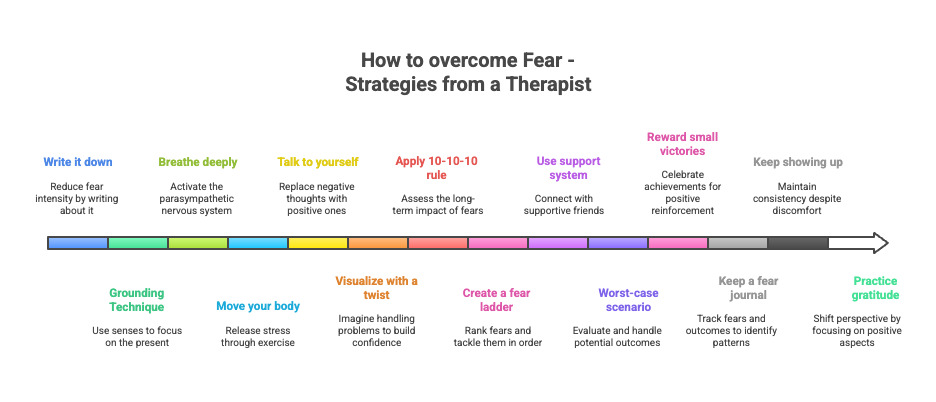
Amaha / / / How to Overcome Fear and Phobias : Science-Backed Methods That Work
ARTICLE | 6 MINS READ
How to Overcome Fear and Phobias : Science-Backed Methods That Work
Published on
22nd Aug 2025

Dr Janani Vasanth
MD Psychiatry

98% of what we worry about never actually happens? Yet here we are, letting fear control our decisions, from avoiding applying to a job, launching a side hustle or skipping meeting our friends because we're terrified of judgment.
Fear isn't just some abstract emotion floating around in your head. It's hardwired into our survival system, dating back to when our ancestors needed to escape saber-toothed tigers. Today, that same system activates when your boss calls an unexpected meeting or when you have to give a presentation.
As psychiatrist Dr. Divya Nallur from Amaha, Bangalore who works with severe mental health cases at Amaha’s mental health hospital says, "Walk directly toward the thing you fear. In its shadow, you will find it is always smaller than your light."
Science Behind Why We Feel Fearful and Avoid taking Action to overcome Fear
Your brain has this tiny almond-shaped structure called the amygdala. The job of the amygdala is to keep you safe. The moment it senses potential danger, it floods your system with stress hormones like adrenaline and cortisol. Your amygdala can't tell the difference between a real threat and an imagined one. Whether it's a speeding truck or the thought of speaking in front of your colleagues, the response is identical. Your body prepares for fight, flight, or freeze.
This explains why your palms get sweaty before a presentation, or why you feel nauseous thinking about that difficult conversation with your boss.

Is your Fear causing you everyday distress?
Fear and anxiety are manageable, take this assessment to understand the severity of your symptoms
What Actually Causes Our Deepest Fears?
Fears are products of our experiences, cultural conditioning, and genetic predisposition. Growing up in Indian households, many of us learned that social judgment is a genuine concern. This social conditioning creates deep-rooted fear responses around judgment and rejection.
Some fears develop from direct experiences. Maybe you fell off a bike once, and now cycling makes you anxious. Fears are also learned from observation: research shows that children as young as two can develop specific phobias just by watching their parents' reactions affecting their childhood experiences. If mama jumps at every lizard, chances are you might too.
Just as your brain learns fear, it can unlearn it. Scientists call this neuroplasticity - the brain’s ability to rewire itself. Small, repeated steps train your nervous system to calm down in fearful situations. Techniques like exposure therapy, mindfulness, and controlled breathing literally teach your brain new patterns.
9 Common Fears & Phobias - How to overcome them
1. Overcome Fear of Rejections or Social interactions (Agoraphobia or social fear):
The fear of being judged or embarrassed in social situations or someone saying something hurtful to you in front of others.
Three ways to overcome agoraphobia:
- Start small. Practice conversations with the shopkeeper or even your watchman to getting used to talking to strangers
- Challenge your thoughts. Ask yourself: "Is everyone really watching me, or am I just assuming?" Practice the "spotlight effect" reality check: most people are too busy worrying about themselves to judge you
- Join group activities where the focus isn't entirely on you, like volunteering or hobby classes
2. Overcome Fear of Public Speaking (Glossophobia):
Standing on stage can make even confident people go blank, this shows up in office meetings, classrooms, or even social events.
Practical approaches to overcome fear of public speaking:
- Use pauses instead of rushing; silence makes you sound more confident.
- Practise with small audiences first - family, friends, colleagues.
- Focus on one friendly face in the audience instead of the whole crowd.
- Break your speech into sections - it feels less overwhelming.
3. Overcome Fear of Failure (Atychiphobia):
This one's particularly strong in our achievement-oriented culture. Tied to success and deep rooted societal expectations.
Approaches to overcome fear of failure:
- Reframe failure as data collection. Every "failure" teaches you something valuable
- Set smaller, achievable goals. Build confidence through small wins
- Surround yourself with people who encourage effort, not just outcomes.
- Remember that most successful people failed multiple times before succeeding
4. Overcome Fear of Heights (Acrophobia):
More common than you'd think, especially in urban India with all these high-rises.
Strategies to overcome fear of heights:
- Gradual exposure. Start with the second floor, then work your way up
- Practice relaxation techniques while at manageable heights
- Use virtual reality exposure therapy if available
- Start small - stand on the first floor, then gradually move higher.
5. Overcome Fear of Speaking to Authority (Boss/Teachers/Police)
Deep rooted cultural respect and demand for authority towards elders often turns into anxiety.
Strategies to overcome fear of speaking to authority:
- Rehearse what you want to say beforehand.
- Remind yourself that they’re human too, not above mistakes. Do not put people on pedestals.
- Use assertive, simple sentences; don’t over-explain.
6. Overcome Fear of Exams (Test Anxiety)
A big one in India, where board exams and competitive tests shape futures.
Three Practical Strategies:
- Prepare with timed mock tests to simulate real pressure.
- Practise meditation or short walks before studying to improve focus.
- Use positive affirmations: “I’m prepared, I can handle this.”
7. Overcome Fear of Intimacy and Commitment
Whether it's arranged marriages creating pressure or past relationships leaving scars, many young Indians struggle with getting close to others.
How to tackle it:
- Start with emotional intimacy. Share small vulnerabilities with trusted friends
- Identify your specific triggers. Is it the fear of being hurt or losing independence?
- Practice self-compassion. You can't love others fully if you're constantly criticizing yourself
8. Overcome Fear of Death (Thanatophobia)
This existential fear often hits during stressful periods or after losing someone close. It's that 3 AM panic about mortality that keeps you awake scrolling through your phone.
Strategies to overcome fear of death:
- Focus on what you can control today. Death anxiety often stems from feeling powerless
- Practice mindfulness meditation. Being present reduces future-focused worries
- Talk to trusted friends or a counselor. This fear loses power when shared
9. Overcome Fear of Flying (Aviophobia)
Especially tough when your dream job requires travel or when your family lives abroad. The turbulence, the enclosed space, the lack of control.
Strategies to overcome fear of flying:
- Learn about flight safety statistics. Flying is statistically safer than driving to the airport
- Practice breathing exercises during takeoff and landing simulations on YouTube
- Bring noise-canceling headphones and create a calming playlist. Familiar sounds reduce anxiety

14 Practical Ways to Overcome Fear Fast
1. Write it down - Worry about your fear on paper:
Simply writing "I'm feeling anxious about this presentation" reduces the fear's intensity by up to 50%. Writing down your fear helps you unload things
2. The 5-4-3-2-1 Grounding Technique:
Notice 5 things you can see, 4 you can touch, 3 you can hear, 2 you can smell, and 1 you can taste. This grounds you in the present moment.
3. Breathe slowly and deeply:
Deep belly breathing activates your parasympathetic nervous system. Four counts in, hold for four, four counts out.
4. Move Your Body, Exercise to release built-up stress:
Even five minutes of walking can reduce anxiety hormones significantly.
5. Talk to Yourself Like a Good Friend:
Replace "I can't do this" with "This is challenging, but I'll figure it out."
6. Visualization with a Twist:
Instead of just imagining success, visualize yourself handling problems that might arise. This builds confidence in your ability to cope.
7. The 10-10-10 Rule:
Will this matter in 10 minutes? 10 months? 10 years? Most fears fail this test.
8. Create a Fear Ladder:
List your fear from 1-10 intensity. Start conquering the 3s and 4s before tackling the 8s and 9s.
9. Use Your Support System:
Call that friend who always makes you laugh. Social connection is a powerful fear reducer.
10. Practice the "What's the Worst That Could Happen" Exercise:
Often, when you really think about it, the worst-case scenario isn't that terrible and check with yourself if you can handle the worst-case scenario? Most probably you will be able to handle it. Replace worst-case thinking with “what’s the best that could happen?”
11. Reward Small Victories, break tasks into smaller steps:
Faced a fear today, even a tiny one? Celebrate it. Your brain needs positive reinforcement.
12. Keep a Fear Journal:
Track your fears and how they turned out. You'll start noticing patterns and false alarms.
13. Keep showing up, even if it feels uncomfortable:
You do not need to do your 100% everyday that is not realistic, understand it’s a journey some days you are 5% and some days you are 105%
14. Practise gratitude to shift perspective
How Therapy Can Help with Overcoming Fear
Sometimes, DIY and self-care approaches aren't enough. Cognitive Behavioral Therapy (CBT) is particularly effective for fears and phobias. A therapist helps you identify negative thought patterns and replace them with more realistic ones. Exposure therapy sounds scarier than it is. It's about gradually facing your fears in a controlled, safe environment. EMDR (Eye Movement Desensitization and Reprocessing) works wonders for trauma-related fears. It helps your brain process frightening memories differently.
In India, organisations like Amaha are making therapy more accessible. Many therapists now offer online sessions, making it easier to get help without the stigma of visiting a clinic.

Join Amaha's Community for Overcoming Fear and Anxiety
Get Tips & Tricks to overcome Fear in everyday Life
Frequently Asked Questions
How long does it take to overcome fear and anxiety completely?
There's no fixed timeline for overcoming fear completely because fear is a natural human emotion that serves a protective purpose. However, most people notice significant improvement in managing their fears within 6-12 weeks of consistent practice using techniques like gradual exposure, breathing exercises, and cognitive restructuring.Some deeper phobias might take several months of therapy to address effectively.
Can fear and phobias be cured permanently without therapy?
While mild fears can often be managed through self-help techniques like the 5-4-3-2-1 grounding method, deep breathing, and gradual exposure, severe phobias typically benefit from professional therapy. Cognitive Behavioral Therapy (CBT) and exposure therapy have success rates of 80-90% for specific phobias. However, many people successfully reduce their fear responses using self-help methods, meditation, and support from friends and family.
Why do some people seem naturally fearless while others are more anxious?
Fear sensitivity varies due to a combination of genetic factors, early childhood experiences, and cultural conditioning. Some people have naturally lower amygdala reactivity, while others may have learned better coping strategies early in life. Additionally, what appears as "fearlessness" might actually be someone who has learned to feel fear but act despite it. Cultural factors also play a significant role.
Is it normal to feel physical symptoms like sweating and shaking when afraid?
Absolutely normal! These physical symptoms are part of your body's fight-or-flight response. When your amygdala detects a threat, it releases stress hormones like adrenaline and cortisol, causing increased heart rate, sweating, shaking, and sometimes nausea. These symptoms show that your survival system is working correctly. The goal isn't to eliminate these responses but to learn that they're temporary and not dangerous themselves.
How can I help my child overcome their fears without making them worse?
Avoid dismissing their fears with phrases like "don't be silly" or "there's nothing to be scared of." Instead, acknowledge their feelings: "I can see you're really scared of the dark." Teach them simple coping techniques like deep breathing or having a comfort object. Gradually expose them to their fears in small, manageable steps while staying calm yourself (children pick up on parental anxiety). Read books about brave characters, and praise them for small acts of courage rather than only the big victories.
What is the difference between fear and anxiety?
Fear is an immediate emotional response to a specific, present threat or danger, while anxiety is persistent worry about potential future problems that may never occur. Fear protects us from real danger; anxiety often creates unnecessary suffering over imagined scenarios.
Was This Article Helpful?
Yes
No



Build a good life for yourself
with Amaha
Best App
for Good
on Google Play India

Amaha is equipped to provide care and support for individuals experiencing severe psychological distress, including complex psychiatric disorders and other complex conditions. For those in need of more intensive care and daily support, we are launching an in-patient care facility in Bengaluru soon.
If you or someone you know is experiencing at-risk behaviors or safety concerns, or any other life-threatening crisis or critical mental health situation, contact a helpline or go to the nearest hospital or emergency room. Having a close family member or friend with you for support can be invaluable during this time.
For emergency mental health support, please call the national Tele MANAS helpline at 1-800 891 4416.